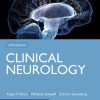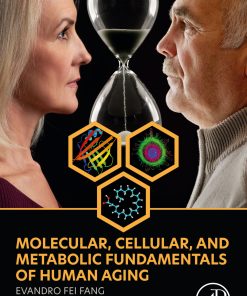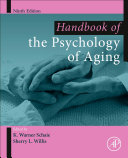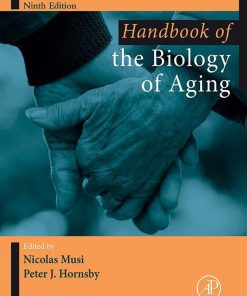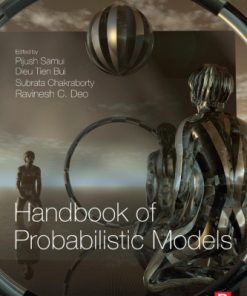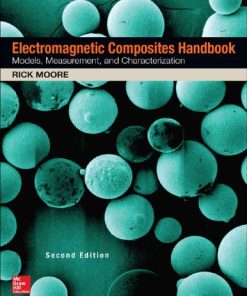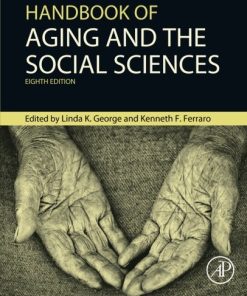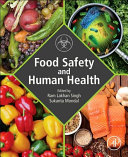(Ebook PDF) Conn’s handbook of models for human aging 2nd Edition by Jeffrey Ram, Michael Conn 0128113545 9780128113547 full chapters
$50.00 Original price was: $50.00.$25.00Current price is: $25.00.
Conn’s handbook of models for human aging 2nd Edition by Jeffrey L. Ram, P. Michael Conn – Ebook PDF Instant Download/DeliveryISBN: 0128113545 9780128113547
Full download Conn’s handbook of models for human aging 2nd Edition after payment.
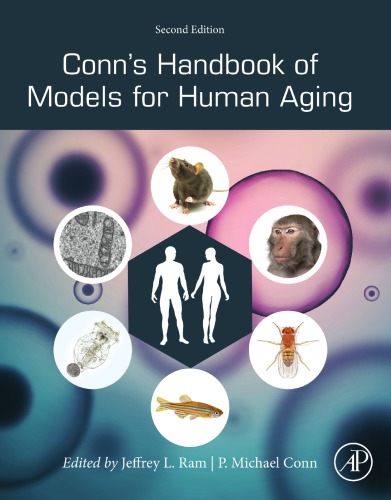
Product details:
ISBN-10 : 0128113545
ISBN-13 : 9780128113547
Author : Jeffrey L. Ram, P. Michael Conn
Conn’s Handbook of Models for Human Aging, Second Edition, presents key aspects of biology, nutrition, factors affecting lifespan, methods of age determination, use in research and the disadvantages/advantages of use. Using a multidisciplinary approach, this updated edition is designed as the only comprehensive, current work that covers the diversity in aging models. Chapters on comparative models explore age-related diseases, including Alzheimer’s, joint disease, cataracts, cancer and obesity. Also included are new tricks and approaches not available in primary publications. This must-have handbook is an indispensable resource for researchers interested in the mechanisms of aging, gerontologists, health professionals, allied health practitioners and students.
Conn’s handbook of models for human aging 2nd Table of contents:
Section I. Aging in Humans
Chapter 1. Werner Syndrome as a Model of Human Aging
Introduction and Historical Overview
Werner Syndrome as a Clinical Disease
Cancer in Werner Syndrome
Clinical Progression of Werner Syndrome
Diagnostic Criteria and Differential Diagnosis
The WRN Gene and Disease-Associated Mutations
Atypical WS/Other Heritable Progeroid Syndromes Distinct From WS
WRN Protein Function in Human Cells
The Relationship of Werner Syndrome to Normal Aging
Experimental Models of Werner Syndrome
Potential Therapeutic Targets and Strategies
Concluding Remarks
Print Resources
Web Resources
Chapter 2. Premature Aging Syndrome
Introduction
Hutchinson–Gilford Progeria and Werner Syndrome
Causative Genes and Molecular Mechanisms
Management and Therapeutic Approaches
Cell Culture Models
Mouse Models
Conclusions
Chapter 3. Models, Definitions, and Criteria for Frailty
Introduction
Models and Mechanisms
Definition
Criteria
Conclusion
Recommended Resources
Chapter 4. Immunological Methods and the Concept of Inflammaging in the Study of Human Aging
Introduction
Phenotypic Analyses
Functional Analyses
Inflammaging
A Dysregulatory Approach Integrating the Immune System and Other Systems
Conclusion
Chapter 5. Vulnerability and Experiential Health in Old Age—A Qualitative Perspective
Introduction
Aging in the World of Meanings
Qualitative Methods as the Study of Meanings
The Meaning and Experience of Vulnerability in Old Age
Experiential Health in Old Age
Researching Subjectivity—Comments on Research Ethics
Chapter 6. Body Composition in Older Adults
Introduction
Overview and Understanding of Body Composition and Compartments
Aging-Related Changes in Body Composition
Measurement of Aging-Related Changes in Body Composition in Clinical Practice
Chapter 7. Using Computational Models to Study Aging
Introduction
The Interconnected Nature of Aging
Why Computational Models Are Needed to Study Health Span?
What Is a Computational Model?
The Steps Involved in Building a Computer Model
Mathematical Frameworks
Modeling Software and Modeling Standards
Computational Modeling of Intracellular Processes
Modeling Nutrient Focused Cellular Pathways
Whole Body Models and Health Span
Opportunities and Future Challenges
Conclusions
Chapter 8. A Framework for Uncovering the Roles of Calories and Macronutrients in Health and Aging
Introduction
Calorie Restriction
Invertebrate Models
Mammalian Models
Calorie Restriction: Is It Plausible for Humans?
Studies of Protein and Amino Acid Restriction
Limitations of Single-Nutrient Manipulation Approaches
The Geometric Framework
Geometric Designs for Aging Research
From Insects to Mice
Mapping the Mechanisms of Aging
Conclusion
Chapter 9. Female Reproductive Aging: From Consequences to Mechanisms, Markers, and Treatments
Introduction
Physiologic Age-Related Decline in Fertility and Reproductive Function
Follicle Quality: The Gamete Perspective
Follicle Quality—The Somatic Cell Perspective
Accelerators of Reproductive Aging—Genetics, Lifestyle, and the Environment
Inducers of Reproductive Aging—Iatrogenic Insults
Clinical Assessment of Reproductive Aging
Clinical Screening Methods for Reproductive Aging
Counteracting Reproductive Aging
Summary and Future Directions
Chapter 10. Adrenopause
Animal Models for Adrenopause: The Challenges
The Life History of DHEA(S) Production by the Human Adrenal Cortex
Factors Involved in the Development and Decline of the DHEA(S)-Secreting Zone, the Zona Reticularis
Possible Causes of the Decline of the Zona Reticularis
Natural Animal Models of Adrenopause
Setting Up Humanized Mouse Models of Adrenopause
Summary and Conclusions
Chapter 11. What Sets Iceland Apart in Understanding Human Aging
Introduction
History
Figures and Facts
Lifestyle
Geriatric Care
Research Environment
Biomedical Research in Iceland and Discovery of Drug Targets
The AGES–Reykjavik Study
Conclusions
Section II. Animal Models: Vertebrates
Chapter 12. Reproductive Tract Lesions in Aged Nonhuman Primates
Introduction
Female Reproductive System
Male Reproductive System
Conclusion
Chapter 13. Age-Related Changes to the Bony Structure and Musculature of the Shoulder in a Nonhuman Primate Model
Introduction
Discussion
Chapter 14. The Dog as a Model for Aging Research
Introduction
Canine Aging-Associated Disease Studies
Canine Aging-Associated Mechanistic Studies
Canine Life Span and Intervention Studies
Conclusions
Chapter 15. The Domestic Dog as a Model for Human Brain Aging and Alzheimer’s Disease
Introduction
Alzheimer’s Disease
Animal Models of Alzheimer’s Disease
Cognitive Function and Aging in Companion Dogs
Neuropathology Related to Canine Brain Aging and Cognitive Dysfunction
The Dog as a Model in Alzheimer’s Disease Research and Drug Development
Conclusions
Chapter 16. Determining Cause of Death and Contributing Causes of Death in Rodent Aging Studies
Introduction
Challenges and Pitfalls in Cause-of-Death Determination in Rodent Aging Studies
Methods
Case Example: Cause-of-Death Analysis in a Cohort of Aged Male C57Bl/6 Mice Treated With Vehicle or Systemic Rapamycin
Conclusion
Chapter 17. Rat Models of Cognitive Aging
Introduction
Aging and the Medial Temporal Lobe
Aging and the Prefrontal Cortex
Concluding Remarks
Chapter 18. Life Extension in Dwarf Mice
Introduction
Origin and Characteristics of Snell Dwarf and Ames Dwarf Mice
Longevity of Dwarf Mice
Growth Hormone Receptor Knockout Mice
Other Mutations Affecting the Somatotropic Axis
Cognitive Function of Ames Dwarf Mice: Possible Role of Hippocampal IGF1 Expression
Altered Insulin Signaling as a Potential Mechanism of Extended Longevity
Molecular, Cellular, and Biological Mechanisms That May Delay Aging and Extend Health Span in Dwarf Mice
Other Mechanisms of Delayed Aging and Extended Longevity of Dwarf Mice
Somatotropic Signaling and Aging in Other Species
Controversies Surrounding Relationship of Somatotropic Signaling to Human Aging
Breeding and Husbandry of Long-Lived Dwarf Mice
Chapter 19. Extension of Life Span in Laboratory Mice
Introduction
Nutritional Manipulations That Increase Life Span
Genetic Manipulations That Increase Life Span
Conclusions
Chapter 20. Development and Validation of ECG Analysis Algorithm in Mice
Introduction
Materials and Methods
Results
Discussion
Chapter 21. Old Gray Mouse Lemur Behavior, Cognition, and Neuropathology
Introduction
Behavior
Cognition
Neuropathology
Therapeutic Aspects
Conclusion
Chapter 22. Birds as Models for the Biology of Aging and Aging-Related Disease: An Update
Introduction: Birds as Long-Lived, Aging-Resistant Animal Models
Some Avian Species Are Well Established as Laboratory Models for Aging
Biomarkers of Aging in Wild or Captive Bird Populations
Avian Aging, Biomarkers, and Strong Inference
Chapter 23. Telomeres and Telomerase in Birds: Measuring Health, Environmental Stress, and Longevity
Introduction
Telomeres, Aging, and Longevity
Unique Telomere Arrays in Birds
Measures of Telomere Shortening
Telomere Shortening as a Biomarker of Stress
The Ecology of Stress
Caveats and Conclusions
Chapter 24. Zebrafish Model for Investigating the Integrated Control of Reproduction
Introduction
Zebrafish Gonadal Development and Organization
Zebrafish Hypothalamic–Pituitary–Gonadal Axis
Zebrafish as a Model for the Study of the Congenital Isolated GnRH Deficiency
Zebrafish as a Model for the Study of the Endocrine-Disrupting Compound Effect on the HPG Axis
Conclusion
Chapter 25. Modeling Aging and Age-Associated Pathology in Zebrafish
The Pleiotropic Nature of Aging
Zebrafish as a Short-Lived Vertebrate Gerontology Model
Growth, Senescence, and Self-Repair in the Aging Zebrafish
Disease Modeling in Zebrafish
Conclusion
Chapter 26. The Use of Mature Zebrafish (Danio rerio) as a Model for Human Aging and Disease
Introduction
Husbandry of an Aging Zebrafish Colony
Zebrafish as Model for Human Disease
Zebrafish Models of Blood Disorders
Zebrafish as a Model for Aging
Heat Shock Proteins
Summary
Chapter 27. Piscine Polemics: Small Tropical Fish Species as Models for Aging Research
Why Study Fish Aging?
The School of Gerontological Small Laboratory Fish
The Race to the Bottom: The Dead-End of Shortevity
Reaching for the Heights: Increasing Longevity
Summary
Chapter 28. The Short-Lived African Turquoise Killifish (Nothobranchius furzeri): A New Model System for Research on Aging
Introduction
The Phenotypic Spectrum of Aging in Turquoise Killifish
The Turquoise Killifish Genome Project
Transgenesis and Genome Editing
Evolutionary Ecology of Life History Trait Evolution
Future Promises and Challenges for the Turquoise Killifish as a Model Organism
Appendix
Section III. Cellular Models and Invertebrates
Chapter 29. A Budding Topic: Modeling Aging and Longevity in Yeast
Introduction
Replicative Aging
Chronological Life Span
Longevity Drugs and Treatments
Hormesis
Emerging Technologies and High-Throughput Methods
Summary and Future Directions
Chapter 30. The Budding and Fission Yeast Model Systems for Aging Biology: Rapid Advancement With New Technologies
Introduction
Replicative Life Span in Saccharomyces cerevisiae
Generation of Saccharomyces cerevisiae Cell Populations From Late in the Replicative Life Span
Quantitative Trait Locus Analysis in Yeast Replicative Life Span Analysis
Microscopy and Microfluidics: Surprises for Schizosaccharomyces pombe Replicative Life Span and Closer Scrutiny for Saccharomyces cerevisiae
High-Throughput Advances for Chronological Life Span and New Attention for Quiescent Cells
Conclusion
Chapter 31. Podospora anserina: A Filamentous Fungus With a Strong Mitochondrial Etiology of Aging
Introduction
Podospora anserina as an In Vivo Model to Identify and Analyze Molecular Processes Active in the Control of Mitochondrial Function
Mitochondrial Respiration
Reactive Oxygen Species Scavenging
Degradation of Proteins by Proteases
Autophagy/Mitophagy
Mitochondrial Dynamics
Programmed Cell Death
Conclusions
Chapter 32. Invertebrates as Model Organisms for Research on Aging Biology
The Worm and the Fly
Beyond the Worm and the Fly
Future Directions
Chapter 33. Invertebrate Models for the Study of the Effects of Age on Neurotransmitter Release
Introduction
Aplysia californica
Drosophila melanogaster
Conclusion
Chapter 34. Impact of Chronic Exercise on Invertebrate Functional Aging
Exercise and Healthy Aging
Invertebrate Exercise Models
Genetic Mediators
Physiological Interactors
Chapter 35. The Virtues and Challenges of Multidimensional Analyses of Whole Brains During Aging With Single Cell Resolution
Introduction
Brain Aging Affects Cell Numbers and Gene Expression Levels
Tissue Homogenates Produce Homogenized and Noisy Averages of Gene Expression
Alternative Methods to Analyze Cell Death in the Adult Brain and Their Limitations
Going Single Cell
Single Cells in 3D Space Over Time: The Beginning of Multidimensional Analyses
The Virtues of Invertebrate Mini-Brains and the Powerful Tools of Drosophila
Single Cell Resolution Allows for Determining Neuronal Death and Extinction at Different Ages and Positions
Future Directions: The Next Steps for Multidimensional Analyses of Aging Brain With Single Cell Resolution
Chapter 36. Rotifers as a Model for the Biology of Aging
Introduction
Rotifer Biology
Advantages of Rotifers for Aging Research
Aging Research in Rotifers
Summary
Chapter 37. The Potential of Comparative Biology to Reveal Mechanisms of Aging in Rotifers
Introduction
Comparative Biology of Aging Within a Genetic Clone
Comparative Biology of Aging Within and Between Species
Summary
Chapter 38. Hydra, a Model System for Deciphering the Mechanisms of Aging and Resistance to Aging
Hydra vulgaris, a Slow- or No-Aging Animal
Hydra oligactis, a Model for Inducible Aging
Evolutionary Conservation of the Human Aging Gene Families in Hydra
Bypassing Stem Cell Exhaustion
No Evidences for Cellular Senescence in Hydra
Bypassing Deregulated Nutrient Sensing
Bypassing Mitochondrial Dysfunction
Bypassing Genomic Instability
Bypassing Telomere Attrition
Bypassing Epigenetic Alterations
Bypassing the Loss of Proteostasis
Conclusions and Perspectives
Chapter 39. Regeneration and Aging in the Tunicate Ciona intestinalis
Introduction
Ciona intestinalis Biology
Ciona intestinalis, an Ideal Model in Regenerative and Aging Biology
Partial Body Regeneration
Aging and Regeneration
Ciona intestinalis Stem Cell Niches
Cellular Events of Oral Siphon Regeneration
Molecular Events of Oral Siphon Regeneration
Conclusions and Prospects
Chapter 40. Honeybee Workers as Models of Aging
Introduction
The Honeybee Society
The Life Span of Worker Bees
Conclusion
Section IV. Disease Models
Chapter 41. Approaches to the Assessment of Frailty in Animal Models
Introduction
Development of Frailty Assessment Tools in Animals
Optimization of Frailty Assessment Tools in Animal Models
Applications of Frailty Assessment Tools in Animal Models
Development of New Frailty Assessment Tools in Other Animal Models
Conclusions
Chapter 42. Genotype and Sex Differences in Longevity in Transgenic Mouse Models of Alzheimer’s Disease
Introduction
The Life Span of Alzheimer’s Disease Model Mice
Connecting Longevity and Alzheimer’s Disease Using Senescence-Prone Mice
Methods of Studying Longevity and Aging—Establishing a Common Scale
Factors Influencing Mouse Life Span
Conclusions
Chapter 43. Animal Models of Vascular Cognitive Impairment and Dementia
Introduction
Bilateral Common Carotid Artery Stenosis: Primary Vascular Pathology—Subcortical Ischemic Injury
Asymmetrical Common Carotid Artery Stenosis: Primary Pathology—Subcortical Ischemic Injury
Vessel Occlusion Models: Primary Pathology—Global Ischemia and Neurodegeneration
Cerebral Small Vessel Disease Model: Primary Pathology—White Matter Hyperintensities and Microinfarcts
Hyperhomocysteinemia Model: Primary Vascular Pathology—Microhemorrhage
Type 2 Diabetic Mellitus: Primary Pathology—Chronic Ischemia, Infarcts, and Stroke
Amyloid Precursor Protein Transgenic Models: Primary Pathology—Cerebral Amyloid Angiopathy and Accompanying Microhemorrhage
Cerebral Autosomal Dominant Arteriopathy With Subcortical Infarcts and Leukoencephalopathy
Conclusions
Chapter 44. Alzheimer’s Dementia Drug Discovery: Targeting Synaptic Glutamate Uptake
Introduction
The Amyloid Hypothesis
Synaptic Glutamate Signaling
Why Targeting EAAT2 and Synaptic Glutamate Uptake Makes Sense
Liposome Glutamate Uptake
Caenorhabditis elegans Studies
Chapter 45. A Transgenic Monkey Model of Huntington’s Disease
Introduction
Large Transgenic Animal Models of Huntington’s Disease
Why the Nonhuman Primate Model for Neurological Disorders
Transgenic Monkey Model of Huntington’s Disease
Neural Stem Cells in Regenerative Medine in Huntington’s Disease
Huntington’s Disease Modeling Using NSCs and NPCs
Neural Stem Cells in Drug/Therapy Discovery
Conclusion
Chapter 46. Parkinson’s Disease in Humans and in Nonhuman Primate Aging and Neurotoxin Models
Introduction
Defining Parkinson’s Disease Today
Mechanisms of Parkinson’s Disease Neuronal Loss
Current Parkinson’s Disease Treatments
Modeling Parkinson’s Disease in Nonhuman Primates
Aging
Environmental Toxins
Other Models of Parkinson’s Disease
Chapter 47. Genetic Models of Parkinson’s Disease and Their Study in Nonhuman Primates
Introduction
Old World Monkey Models of Genetic Parkinson’s Disease
New World Monkey Models of Genetic Parkinson’s Disease
Matching Models to Scientific Questions
Next Steps in Nonhuman Primate Parkinson’s Disease Research
Chapter 48. Impact of the Aged Brain Environment on Gene Therapy for Parkinson’s Disease
Parkinson’s Disease
Parkinson’s Disease Treatments
Neurotrophic Strategy for Neuroprotection
Viral Vector-Mediated Neurotrophic Factor Delivery for Parkinson’s Disease
Viral Vector-Mediated Gene Therapy in the Aged Brain
Direct Comparisons of Viral Vector Transduction Efficiency Between Young Adult and Aged Rodents—Early Studies
Effect of Advanced Age on Transgene Expression in Parkinson’s Disease-Relevant Brain Circuitry—Systematic Evaluation Using the GFP Reporter Protein
Effect of Advanced Age on Transgene Expression in Parkinson’s Disease-Relevant Brain Circuitry—Evaluation Using the Clinically Relevant GDNF Protein
Conclusions: Using Viral Vectors in Aged Animal Models
Chapter 49. Cell Therapy for Parkinson’s Disease
Clinical Trials Using Human Fetal Ventral Mesencephalon Tissue Transplants
New Hope From Reprogrammed Cells
Animal Models of Parkinson’s Disease
Toxin-Induced Parkinson’s Disease Models
Rotenone
Paraquat/Maneb
Genetic Rodent Models
Virus-Mediated Injection
Leucine-Rich Repeat Kinase 2
Parkin
PTEN-Induced Putative Kinase 1
DJ-1
Concluding Remarks
Chapter 50. Genetics of Progeria and Aging
Introduction
Hutchinson–Gilford Progeria Syndrome and Lamin A
Pathophysiology of Hutchinson–Gilford Progeria Syndrome
Therapeutic Schemes for Hutchinson–Gilford Progeria Syndrome
Mouse Models
Molecular Mechanisms Behind Hutchinson–Gilford Progeria Syndrome
Hutchinson–Gilford Progeria Syndrome and Physiological Aging
Chapter 51. Progeria Mouse Models
Introduction
Zmpste24-Deficient Mouse
LmnaG609G/G609G Mouse Model
Other Mouse Models of Progeria Caused by Mutations in Lmna
Therapeutic Approaches for Progeria
Conclusions and Perspectives
Chapter 52. Models of Hypertension in Aging
Introduction
Models of Hypertension
Conclusion
Chapter 53. Osteoporosis and Cardiovascular Disease in the Elderly
Introduction
Association of Osteoporosis and Cardiovascular Disease
Common Underlying Mechanisms for Atherosclerosis and Osteoporosis
The OPG/RANKL/RANK System
Gamma-Carboxyglutamic Acid Proteins
Osteocalcin
Osteopontin and Bone Morphogenetic Proteins
Role of Nitric Oxide
Sex Steroids
High-Density Lipoprotein–Associated Paraoxonase-1
Inflammation
Dyslipidemia
Homocysteinemia
Hypertension
Diabetes Mellitus
Renin–Angiotensin and Aldosterone System
Fibroblast Growth Factor-23
Pharmacologic Agents
Conclusion
Chapter 54. The Role of the Tumor Microenvironment in Pancreatic Ductal Adenocarcinoma and Preclinical Models to Study It
The Role of the Tumor Microenvironment in Pancreatic Ductal Adenocarcinoma
Models Used in Pancreatic Cancer
Conclusion
Section V. Organ Systems
Chapter 55. Alopecia
Introduction to Hair Growth
Skin, Hair Follicles, and Stem Cells
Alopecia
Differences Between Mouse and Man
Androgenetic Alopecia
Alopecia Areata
Chemotherapy-Induced Alopecia
Conclusion
Chapter 56. Experimental Models of Human Skin Aging
Introduction
Human Skin
Animal Models
Progeria Syndromes as Models of Understanding Skin Aging
Monolayer Cultures
Hormonal Regulation of Aging
Three-Dimensional Skin Models: Reconstructed Aged Skin
Conclusion
Chapter 57. Muscle Deconditioning and Aging: Experimental Models
Introduction
Sarcopenia: Consensus Definition and Diagnostic Criteria
Muscle Deconditioning Experimental Models
Chapter 58. Models of Immune Aging
Immune Aging and Immunosenescence
Human Models of Accelerated Immune Aging
Rodent Models of Immune Aging
In Vitro Cultured T-Cell Clones as an In Vitro Model of Immune Aging
The System Biology Approach to Immune Aging
Chapter 59. Sex and the Aging Immune System
Overview of Models Useful for Studying Sex-Specific Aging-Related Changes to the Immune System and Their Association With Age-Related Infectious and Chronic Disease
Cellular Senescence as It Relates to the Immune System
Aging-Related Changes to the Immune System in Males and Females
Human Datasets to Study Sex-Differences Regarding Aging-Related Decline of the Immune System
Aging of the Immune System and Relevance to Infectious Disease
Conclusion
Chapter 60. Rodent Models of Ovarian Failure
Introduction
Rodent Endocrinology
Rodent Models of Ovarian Failure
Hypertension as an Illustration of Ovarian Failure Models
Conclusion
Chapter 61. Role of Sex and Aging in Mucosal Health
Introduction
Conclusion
Chapter 62. Leydig Cell Development and Aging in the Brown Norway Rat: Mechanisms and Consequences
Introduction
Testosterone Formation
Age-Related Changes in Serum Testosterone Levels in Men
The Brown Norway Rat as a Model for Human Male Reproductive Aging
Age-Related Changes in Testosterone Production by Brown Norway Rat Leydig Cells
Oxidative Stress and Testosterone Production by Aging Brown Norway Rat Leydig Cells
Delay/Prevention of Age-Related Reductions in Testosterone
Reversal of Age-Related Reductions in Testosterone
Summary
Chapter 63. Models of Aging Kidney: Implications on Kidney Health and Disease
Introduction
Chapter 64. Age-Associated Changes in Structure and Function of the Aging Human Lung
Introduction
Age-Associated Changes in Lung Structure and Function Attributed to the Normal Aging Process
Animal Models and Observations in Humans
Summary
Chapter 65. Glucose, Insulin, and Human Brain Aging
Models of Aging—A Global Perspective
The Human Brain
Brain Changes With Aging: Macrostructural Brain Aging
Brain Changes With Aging: Microstructural Brain Aging
Homeostatic Maintenance of Glucose and Insulin
Insulin and the Brain
Insulin Receptors in the Brain
Brain Changes With Insulin
Clinical Importance of Insulin Activity in the Brain
Intranasal Insulin—Mechanisms of Action
Increased Central Nervous System Insulin: A Promising New Model to Improve Brain Aging
Chapter 66. Pathology of Brain Aging and Animal Models of Neurodegenerative Diseases
Spontaneous Age-Related Brain Lesions
Transgenic Rodents Models of Brain Aging and Age-Related Neurodegenerative Diseases
Chapter 67. Leptin and Aging in Animal Models
Introduction
Mechanisms of Leptin Resistance
Development of Leptin Resistance During the Course of Aging
Conclusions and Perspectives
Chapter 68. Age-Related Changes to Bone Structure and Quality in Rodent Models
Introduction
Age-Related Changes in Areal and Volumetric Bone Mineral Density
Age-Related Changes in Cortical Bone Structure
Age-Related Changes in Trabecular Architecture
Age-Related Changes in Whole-Bone Biomechanical Properties
Age-Related Changes in Apparent-Level Material Properties
Age-Related Changes in Microporosity and in Tissue Composition
Age-Related Changes in Tissue-Level Mechanical Properties
Conclusions
Section VI. Mechanisms
Chapter 69. Dielectric Properties of Biological Tissues; Variation With Age
Introduction
Dielectric Spectroscopy of Biological Tissues
Variation of Dielectric Properties With Age
Impact of Variation in Dielectric Properties on Dosimetry Studies
Summary
Chapter 70. Experimental Models of Tau Aggregation
Introduction
The Pathophysiology of Tau
In Vitro Models of Tau Aggregation and Spreading
Invertebrate Models of Tau Aggregation and Spreading
Mouse Models of Tauopathy and Tau Spreading
Conclusions
Chapter 71. Aging of Human Mesenchymal Stem Cells
Introduction
Characteristics, Activities, and Functions of Mesenchymal Stem Cells
Natural Aging of Human Mesenchymal Stem Cells
Artifactual Mesenchymal Stem Cell Aging During In Vitro Expansion
Identification and Monitoring of Mesenchymal Stem Cell Aging
Mechanisms Underlying Mesenchymal Stem Cell Aging
Effect of Aging on Mesenchymal Stem Cell–Based Therapy
Strategies to Prevent Mesenchymal Stem Cell Aging and Retain Their Functionality
Conclusion and Outlook
Chapter 72. Helicases and Their Relevance to Aging
Introduction
Double-Strand Breaks and Aging
Double-Strand Break Repair Pathways and RecQ Helicases
Pleiotropic Roles of Fe–S Helicases in Genomic Stability, DNA Repair, and Transcription
Chromatin Maintenance, Werner Syndrome Protein Helicase, and Aging
Changes in the Transcriptome and Proteome During Cellular Senescence
G-Quadruplex DNA and Its Importance in DNA Metabolism and Gene Expression
G-Quadruplex Resolving DNA Helicases Implicated in Accelerated Aging Disorders
Roles of DNA Helicases to Modulate Gene Expression via Interactions With Guanine-Rich Promoters
Clinical Significance of G4-Interactive Helicases and Their Regulation of Gene Expression
Repeat Expansion Disorders Prevalent in Aging
DNA Replication and Repeat Expansion
DNA Repair and Repeat Expansion
Transcription and Repeat Expansion
Roles of DNA Helicases in Repeat Expansion
Mouse Models for Helicase Deficiency
Blm
Wrn
Recql4
Recql1
Recql5
Rtel
ChlR1
Xpd
Fancj
Dna2
Pif1
Twinkle
Summary of Mouse Models
Conclusions
Chapter 73. Genetics of Human Aging
Why to Study Aging in Humans: From Theory to Biological Discovery
Value of Animal Models in Aging Genetics
Theories of Aging
Genome-Wide Association Study Approach
Genome-Wide Association Study With Surrogate Aging Phenotype
From Array-Based Genotype to Next Generation Sequencing
Identifying Pleiotropic Loci for Aging Phenotypes
Epigenetic Studies
Future of Genetic Study in Human Aging
Chapter 74. Epigenetics of Brain Aging
Introduction
Epigenetic Mechanisms
DNA Methylation Changes in Brain During Aging
Chromatin Remodeling in Brain During Aging
Other Age-Mediated Epigenetic Modifications
Mitochondrial-Related Epigenetics of Aging
Epigenetic Modifications Involving Age-Related Neurodegeneration: Epigenetic Hallmarks of Alzheimer’s Disease
Role of Pharmacoepigenomics in Drug Response and Drug Resistance
Conclusions and Future Directions
Chapter 75. The Circadian Clock and the Aging Process
Introduction
The Mammalian Circadian Clock
Circadian Mouse Models and Aging
The Circadian Clock Impacts the NAD+ Metabolism and Downstream Processes
Conclusions
Chapter 76. Super DNAging—New Insights Into DNA Integrity, Genome Stability, and Telomeres in the Oldest Old
Introduction
DNA Integrity
Genome Stability
Telomeres
Cell-Free DNA
Concluding Remarks of the Review
Behavioral Strategies for Successful “DNAging”
Conclusion
Chapter 77. Model of Chaperones in Aging
Introduction
Classes and Functions of Molecular Chaperones
Chaperones in Aging and Longevity
Conclusions
Future Perspectives
Chapter 78. Chaperone-Mediated Autophagy
Introduction
Chaperone-Mediated Autophagy
Lysosomal mTORC2/PHLPP1/Akt1 Signaling Pathway Regulates LAMP-2A Receptor Dynamics
Chaperone-Mediated Autophagy Decline in Aging
Physiological Functions of Chaperone-Mediated Autophagy and Consequences of Its Failure
Cross Talk Between Chaperone-Mediated Autophagy and Other Proteolytic Pathways in Management of Proteostasis
Chaperone-Mediated Autophagy Dysfunction in Neurodegeneration
Lysosome-Associated Membrane Protein 2A Deficient Models
Concluding Remarks
Chapter 79. Resveratrol in Aging and Age-Related Diseases
What is Resveratrol?
Longevity
Obesity/Diabetes
Cardiovascular Disease
Neurological Diseases
Cancer
Conclusions
Chapter 80. Resveratrol in Experimental Models and Humans
Introduction
Longevity and Oxidative Stress
Pathologies
Health and Diet
People also search for Conn’s handbook of models for human aging 2nd:
human needs theory of aging
conn’s handbook of models for human aging
handbook of models for human aging
concepts of aging
models of aging
Tags:
Conn’s handbook,models,human aging,Jeffrey Ram,Michael Conn
You may also like…
Psychology - Developmental Psychology
Handbook of the Psychology of Aging 9th Edition by Warner Schaie 0128162972 9780128162972
Biology and other natural sciences - Human Biology
Medicine - Medicine & Nursing Reference
Engineering
Electromagnetic Composites Handbook: Models, Measurement, and Characterization 2nd Edition
Politics & Philosophy - Social Sciences


